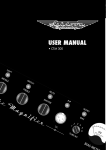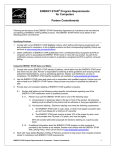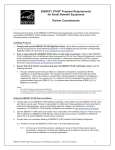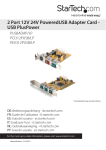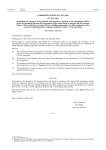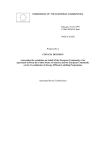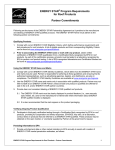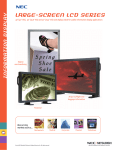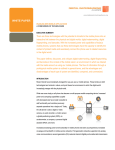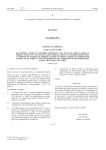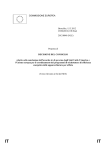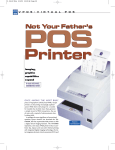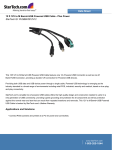Download Displays version 5.0
Transcript
ENERGY STAR® Program Requirements for Displays Table of Contents Partner Commitments................................................................................................................................. 2 Commitment.............................................................................................................................................. 2 Performance for Special Distinction.......................................................................................................... 3 Eligibility Criteria......................................................................................................................................... 5 1) Definitions......................................................................................................................................... 5 2) Qualifying Products .......................................................................................................................... 5 3) Energy-Efficiency Criteria................................................................................................................. 6 4) Test Requirements ........................................................................................................................... 7 5) User Interface................................................................................................................................. 12 6) Effective Date. ................................................................................................................................ 12 7) Future Specification Revisions ....................................................................................................... 12 ENERGY STAR Program Requirements for Displays (Version 5.0) 1 ENERGY STAR® Program Requirements for Displays Partner Commitments Commitment The following are the terms of the ENERGY STAR Partnership Agreement as it pertains to the manufacturing of ENERGY STAR qualified displays. The ENERGY STAR Partner must adhere to the following program requirements: • comply with current ENERGY STAR Eligibility Criteria, defining the performance criteria that must be met for use of the ENERGY STAR certification mark on displays and specifying the testing criteria for displays. EPA may, at its discretion, conduct tests on products that are referred to as ENERGY STAR qualified. These products may be obtained on the open market, or voluntarily supplied by Partner at EPA’s request; • comply with current ENERGY STAR Identity Guidelines, describing how the ENERGY STAR name and mark may be used. Partner is responsible for adhering to these guidelines and for ensuring that its authorized representatives, such as advertising agencies, dealers, and distributors, are also in compliance; • qualify at least one ENERGY STAR qualified display model within six months of activating the display portion of the agreement. When Partner qualifies the product, it must meet the specification (e.g., Tier 1 or 2) in effect at that time; provide clear and consistent labeling of ENERGY STAR qualified displays. The ENERGY STAR mark must be clearly displayed: 1. On the top or front of the product. Labeling on the top or front of the product may be permanent or temporary. All temporary labeling must be affixed to the top or front of the product with an adhesive or cling-type application; Electronic Labeling Option: Partners have the option of using an alternative electronic labeling approach in place of this product labeling requirement, as long it meets the following requirements: − The ENERGY STAR mark in cyan, black, or white (as described in "The ENERGY STAR Identity Guidelines" available at www.energystar.gov/logos) appears at system start-up. The electronic mark must display for a minimum of 5 seconds; − The ENERGY STAR mark must be at least 10% of the screen by area, may not be smaller than 76 pixels x 78 pixels, and must be legible. EPA will consider alternative proposals regarding approach, duration, or size for electronic labeling on a case-by-case basis. 2. In product literature (i.e., user manuals, spec sheets, etc.); 3. On product packaging for products sold at retail; and 4. On the Partner’s Internet site where information about ENERGY STAR qualified models is displayed: − If information concerning ENERGY STAR is provided on the Partner Web site, as specified by the ENERGY STAR Web Linking Policy (this document can be found in the Partner Resources section on the ENERGY STAR Web site at www.energystar.gov), EPA may provide links where appropriate to the Partner Web site; ENERGY STAR Program Requirements for Displays (Version 5.0) 2 • include information on the importance of power management in either the product manual or as a box insert for displays intended for use with computers. This information should include a reference to the energy saving and environmental benefits of power management for both the display and computer. In addition, where a display is packaged for sale with a computer, a link should be made available to www.energystar.gov/powermanagement from the display and/or computer product pages, product specifications, and related content pages. At the Partner’s request, EPA will supply suggested facts and figures related to the above criteria, template elements, or a complete template suitable for use in user guides or box inserts; • provide to EPA, on at least an annual basis, an updated list of ENERGY STAR qualified display models. Once the Partner submits its first list of ENERGY STAR qualified display models, the Partner will be listed as an ENERGY STAR Partner. Partner must provide an update at least annually in order to remain on the list of participating product Partners. Listing products via the Online Product Submittal OPS tool satisfies the annual update requirement; • provide to EPA, on an annual basis, unit shipment data or other market indicators to assist in determining the market penetration of ENERGY STAR. Specifically, Partner must submit the total number of ENERGY STAR qualified displays shipped (in units by model) or an equivalent measurement as agreed to in advance by EPA and Partner. Partner is also encouraged to provide ENERGY STAR qualified unit shipment data segmented by meaningful product characteristics (e.g., screen size, resolution, or other as relevant), total unit shipments for each model in its product line, and percent of total unit shipments that qualify as ENERGY STAR. The data for each calendar year should be submitted to EPA, preferably in electronic format, no later than the following March and may be provided directly from the Partner or through a third party. The data will be used by EPA only for program evaluation purposes and will be closely controlled. If requested under the Freedom of Information Act (FOIA), EPA will argue that the data is exempt. Any information used will be masked by EPA so as to protect the confidentiality of the Partner; • notify EPA of a change in the designated responsible party or contacts for displays within 30 days. Performance for Special Distinction In order to receive additional recognition and/or support from EPA for its efforts within the Partnership, the ENERGY STAR Partner may consider the following voluntary measures and should keep EPA informed on the progress of these efforts: • consider energy efficiency improvements in company facilities and pursue the ENERGY STAR label for buildings; • purchase ENERGY STAR qualified products. Revise the company purchasing or procurement specifications to include ENERGY STAR. Provide procurement officials’ contact information to EPA for periodic updates and coordination. Circulate general ENERGY STAR qualified product information to employees for use when purchasing products for their homes; • ensure the power management feature is enabled on all ENERGY STAR qualified displays in use in company facilities, particularly upon installation and after service is performed; • provide general information about the ENERGY STAR program to employees whose jobs are relevant to the development, marketing, sales, and service of current ENERGY STAR qualified product models; • feature the ENERGY STAR mark on Partner Web site and in other promotional materials. If information concerning ENERGY STAR is provided on the Partner Web site as specified by the ENERGY STAR Web Linking Policy (this document can be found in the Partner Resources section on the ENERGY STAR Web site at www.energystar.gov), EPA may provide links where appropriate to the Partner Web site; ENERGY STAR Program Requirements for Displays (Version 5.0) 3 • provide a simple plan to EPA outlining specific measures Partner plans to undertake beyond the program requirements listed above. By doing so, EPA may be able to coordinate, communicate, and/or promote Partner’s activities, provide an EPA representative, or include news about the event in the ENERGY STAR newsletter, on the ENERGY STAR Web pages, etc. The plan may be as simple as providing a list of planned activities or planned milestones that Partner would like EPA to be aware of. For example, activities may include: (1) increase the availability of ENERGY STAR qualified products by converting the entire product line within two years to meet ENERGY STAR guidelines; (2) demonstrate the economic and environmental benefits of energy efficiency through special in-store displays twice a year; (3) provide information to users (via the Web site and user’s manual) about energy-saving features and operating characteristics of ENERGY STAR qualified products, and (4) build awareness of the ENERGY STAR Partnership and brand identity by collaborating with EPA on one print advertorial and one live press event; • provide quarterly, written updates to EPA as to the efforts undertaken by Partner to increase availability of ENERGY STAR qualified products, and to promote awareness of ENERGY STAR and its message; • join EPA's SmartWay Transport Partnership to improve the environmental performance of the company's shipping operations. SmartWay Transport works with freight carriers, shippers, and other stakeholders in the goods movement industry to reduce fuel consumption, greenhouse gases, and air pollution. For more information on SmartWay, visit www.epa.gov/smartway; • join EPA's Climate Leaders Partnership to inventory and reduce greenhouse gas emissions. Through participation, companies create a credible record of their accomplishments and receive EPA recognition as corporate environmental leaders. For more information on Climate Leaders, visit www.epa.gov/climateleaders; • join EPA’s Green Power partnership. EPA's Green Power Partnership encourages organizations to buy green power as a way to reduce the environmental impacts associated with traditional fossil fuel-based electricity use. The partnership includes a diverse set of organizations including Fortune 500 companies, small and medium businesses, government institutions as well as a growing number of colleges and universities, visit http://www.epa.gov/grnpower. ENERGY STAR Program Requirements for Displays (Version 5.0) 4 ENERGY STAR® Program Requirements for Displays Eligibility Criteria (Version 5.0) 1) Definitions: Below is a brief description of an Electronic Display and other terms as relevant to ENERGY STAR. A. Electronic Display (also referred to as “Display”): A commercially-available product with a display screen and associated electronics, often encased in a single housing, that as its primary function displays visual information from (i) a computer, workstation or server via one or more inputs, such as VGA, DVI, HDMI, or IEEE 1394, or (ii) a USB flash drive, a memory card, or wireless Internet connection. Common display technologies include liquid crystal display (LCD), light emitting diode (LED), cathode-ray tube (CRT), and plasma display panel (PDP). B. External Power Supply: A component contained in a separate physical enclosure external to the display casing and designed to convert line voltage AC input from the mains to lower DC voltage(s) for the purpose of powering the display. An external power supply (EPS) must connect to the display via a removable or hard-wired male/female electrical connection, cable, cord or other wiring. C. On Mode: The operational mode of a display that is (i) connected to a power source, (ii) has all mechanical (hard) power switches turned on, and (iii) is performing its primary function of producing an image. D. Sleep Mode: The operational mode of a display that is (i) connected to a power source, (ii) has all mechanical (hard) power switches turned on, and (iii) has been placed into a low-power mode by receiving a signal from a connected device (e.g. computer, game console, or set-top box) or by cause of an internal function such as a sleep timer or occupancy sensor. Sleep Mode is considered a “soft” low-power condition, in that the display can be brought out of Sleep Mode by receiving a signal from a connected device or by cause of an internal function. E. Off Mode: The operational mode of a display that is (i) connected to a power source, (ii) engaged by a power switch, and (iii) not providing any function. The user must actuate a mechanical switch to bring the device out of Off Mode. If there is more than one such switch, the tester shall use the most readily available switch. F. Luminance: The photometric measure of the luminous intensity per unit area of light travelling in a given direction. It describes the amount of light that passes through or is emitted from a particular area, and falls within a given solid angle. The standard unit for luminance is candela per square meter (cd/m2). G. Automatic Brightness Control: For displays, automatic brightness controls is the self-acting mechanism which controls brightness of the display as a function of ambient light. 2) Qualifying Products: To qualify for ENERGY STAR, the display must satisfy the following criteria: A. Maximum viewable diagonal screen size: The display must have a viewable diagonal screen size of less than or equal to (≤) 60 inches. B. Power Source: The display must be powered by a separate AC wall outlet, a battery unit that is sold with an AC adapter, or a data or network connection. ENERGY STAR Program Requirements for Displays (Version 5.0) 5 C. Television Tuners: If the display has an integrated television tuner, it may qualify for ENERGY STAR under this specification as long as it is primarily marketed and sold to consumers as a display or as a dual-function display and television. Any display with a television tuner that is marketed and sold exclusively as a television is not eligible to qualify under this specification. Under Tier 2 of this specification, only those displays without tuners may qualify; displays with tuners may qualify under Tier 2 of the Version 3.0 ENERGY STAR TV specification. D. Automatic Brightness Control (ABC): To qualify for ENERGY STAR using the Automatic Brightness Control On Mode power equation, the display must ship with ABC enabled by default. E. External Power Supply: If the display is shipped with an EPS, the EPS must be ENERGY STAR qualified or meet the no-load and active mode efficiency levels provided in the ENERGY STAR Program Requirements for Single Voltage AC-AC and AC-DC External Power Supplies. The ENERGY STAR specification and qualified product list can be found at www.energystar.gov/powersupplies. F. Power Management Requirements: The display must have at least one mechanism enabled by default that allows the display to automatically enter Sleep or Off Mode. For instance, data or network connections must support powering down the display according to standard mechanisms, such as Display Power Management Signaling. Displays generating their own content must have a sensor or timer enabled by default to automatically engage Sleep or Off Mode. 3) Energy-Efficiency Criteria: A. On Mode Requirements: 1. Tier 1: To qualify as ENERGY STAR, the display must not exceed the maximum On Mode power consumption (PO or PO1) as calculated from the equations below. The maximum On Mode power consumption is expressed in watts and rounded to the nearest tenth of a watt. Table 1. Tier 1 On Mode Power Consumption Requirements Maximum On Mode Display Category Power Consumption (W) Diagonal Screen Size < 30 inches PO = 6*(MP) + 0.05*(A) + 3 Screen Resolution ≤ 1.1 MP Diagonal Screen Size < 30 inches PO = 9*(MP) + 0.05*(A) + 3 Screen Resolution > 1.1 MP Diagonal Screen Size 30 - 60 inches PO = 0.27*(A) + 8 All Screen Resolutions MP = Display Resolution (megapixels) A = Viewable Screen Area (square inches) EXAMPLE: The maximum On Mode power consumption for a display with 1440 x 900 resolution, or 1,296,000 pixels, a 19 inch viewable diagonal screen size and a viewable screen area of 162 square inches, would be: ((9 x 1.296) + (0.05 x 162)) + 3 = 22.8 watts when rounded to the nearest tenth of a watt. Table 2. Sample Tier 1 On Mode Maximum Power Consumption Requirements1 Maximum On Diagonal Screen Screen Mode Power Screen Size Resolution Megapixels Dimensions Area Consumption (inches) (inches) (sq. in.) (watts) 7 800 x 480 0.384 5.9 x 3.5 21 6.4 19 1440 x 900 1.296 16.07 x 10.05 162 22.8 26 1920 x 1200 2.304 21.7 x 13.5 293 38.4 42 1360 x 768 1.044 36 x 20 720 202.4 50 1920 x 1080 2.074 44 x 24 1056 293.1 1 For displays between 30 and 60 inches, resolution must be reported when submitting a product for qualification; however, resolution is not considered when calculating the On Mode power consumption of these displays. ENERGY STAR Program Requirements for Displays (Version 5.0) 6 2. Tier 2: To qualify as ENERGY STAR, the display must not exceed the following maximum On Mode consumption equations: TBD. 3. Displays with Automatic Brightness Control: EPA has noted a substantial increase in the default luminance settings of displays since the last revision of this specification. Based on the EPA data set, there is a strong positive relationship between luminance and On Mode power consumption. While EPA recognizes the benefits of offering consumers full-featured products, higher luminance settings tend to negate the power consumption reductions achieved through improved component efficiency. Automatic Brightness Control (ABC) technology can offset the effects of these higher default settings by automatically modulating the luminance of displays under variable ambient lighting conditions. In addition to offering significant energy savings, this feature can also improve the user viewing experience. As with the most recent revision of the ENERGY STAR TV specification, EPA rewards products that ship with ABC features enabled by default. An alternate calculation is used to calculate maximum On Mode power consumption for displays shipped with ABC enabled by default: PO1 = (0.8 * Ph) + (0.2 * Pl) where PO1 is the average On Mode power consumption in watts, rounded to the nearest tenth of a watt, Ph is the On Mode power consumption in high ambient lighting conditions, and Pl is the On Mode power consumption in low ambient lighting conditions. The formula assumes the display will be in low ambient lighting conditions 20% of the time. B. Sleep and Off Mode Requirements: 1. Tiers 1 and 2: To qualify as ENERGY STAR, the display must not exceed the maximum power consumption levels for Sleep and Off Modes provided in Table 3, below. Displays capable of multiple Sleep Modes (i.e., Sleep and Deep Sleep) must meet Sleep Mode requirements in all sleep modes. EXAMPLE: A display test result of 3 watts in Sleep and 2 watts in Deep Sleep would not qualify because power consumption in one of the Sleep Modes exceeded the 2 watt Tier 1 limit. Table 3. Sleep and Off Mode Power Consumption Requirements for all Displays Mode Tier 1 Tier 2 ≤2 ≤1 Maximum Sleep Mode Power Consumption (W) ≤1 ≤1 Maximum Off Mode Power Consumption (W) 4) Test Requirements How to Use this Section EPA utilizes, where possible, widely-accepted industry practices for measuring product performance and power consumption under typical operating conditions. The test methods in this specification are based on standards from the Video Electronics Standards Association (VESA) Display Metrology Committee and the International Electrotechnical Commission (IEC). In cases where the VESA and IEC standards were insufficient for the needs of the ENERGY STAR program, additional testing and measurement methods were developed in cooperation with industry stakeholders. ENERGY STAR Program Requirements for Displays (Version 5.0) 7 To ensure a consistent means for measuring the power consumption of electronics products such that the test results may be reproduced, and that outside factors do not adversely affect the test results, the following protocol must be followed. It has four main components: Test Conditions and Instrumentation Setup Test Method Documentation Note: Test Method is located in Annexes 1 and 2. Annex 1 describes the test procedure for displays with a viewable diagonal screen size measuring less than (<) 30 inches. Annex 2 describes the test procedure for displays with a viewable diagonal screen size measuring from 30 to 60 inches, inclusive. Partners may elect to use an in-house or independent laboratory to provide the test results. Facility Quality Control Partners are required to perform tests and certify those product models that meet the ENERGY STAR guidelines. In order to conduct testing in support of qualification for ENERGY STAR, the product must be tested in a facility that has quality control procedures for monitoring the validity of tests and calibrations. ENERGY STAR recommends conducting these tests in a facility that follows the general requirements for the competence of testing and calibration laboratories as described in the International Standard ISO/IEC 17025. Test Conditions and Instrumentation A. Power Measurement Protocols: The average true power consumption of the display shall be measured during On Mode, Sleep Mode, and Off Mode. When performing measurements to selfcertify a product model, the Unit Under Test (UUT) must initially be in the same condition (e.g., configuration and settings) as when shipped to the customer, unless adjustments need to be made pursuant to the instructions below. 1. Power measurements shall be taken from a point between the outlet or power source and the UUT. 2. If a product’s electrical power comes from Mains, USB, IEEE1394, Power-over-Ethernet, telephone system, or any other means or combinations of means, the net AC electrical power consumed by the product (taking into account AC-to-DC conversion losses) must be used for qualification. 3. Products powered by a standard low voltage DC supply (e.g., USB, USB PlusPower, IEEE 1394, and Power Over Ethernet) shall utilize a suitable AC-powered source of the DC power. This AC-powered source’s energy consumption shall be measured and recorded as the UUT’s power consumption. 4. For a display powered by USB, a powered hub serving only the display being tested shall be used. For a display powered by Power Over Ethernet or USB PlusPower, it is acceptable to measure the power distribution device with and without the display connected, and record the difference between the two readings as the display’s power consumption. The tester should confirm that this reasonably reflects the unit’s DC consumption plus some allowance for power supply and distribution inefficiency. 5. Any product capable of being powered from both AC and standard low-voltage DC sources shall be tested while operating on AC power. ENERGY STAR Program Requirements for Displays (Version 5.0) 8 B. Input AC Power Requirements: Supply Voltage: North America/Taiwan: 115 (± 1%) Volts AC, 60 Hz (± 1%) Europe/Australia/New Zealand: 230 (± 1%) Volts AC, 50 Hz (± 1%) Japan: 100 (± 1%) Volts AC, 50 Hz (± 1%)/60 Hz (± 1%) Note: For products rated for > 1.5 kW maximum power, the voltage range is ± 4% Total Harmonic Distortion < 2% THD (< 5% for products which are rated for > 1.5 kW maximum power) (THD) (Voltage): Ambient Temperature: 23°C ± 5°C Relative Humidity: 10 – 80% (Reference IEC 62301 Ed 1.0: Household Electrical Appliances – Measurement of Standby Power, Sections 4.2, 4.3) C. Approved Meter: Approved meters will include the following attributes.2 An available current crest factor of 3 or more at its rated range value; and Lower bound on the current range of 10mA or less. The power measurement instrument shall have a resolution of: 0.01 W or better for power measurements of 10 W or less; 0.1 W or better for power measurements of greater than 10 W up to 100 W; and 1 W or better for power measurements of greater than 100 W. The following attributes in addition to those above are suggested: Frequency response of at least 3 kHz; and Calibration with a standard that is traceable to the U.S. National Institute of Standards and Technology (NIST). It is also desirable for instruments to be able to measure average power over any user-selected time interval (the most accurate devices perform an internal calculation to divide accumulated energy by elapsed time). As an alternative, the measurement instrument would have to be capable of integrating energy over any user-selected time interval with an energy resolution of less than or equal to 0.1 mWh and integrating time displayed with a resolution of 1 second or less. D. Accuracy: Measurements of power of 0.5 W or greater shall be made with an uncertainty of less than or equal to 2% at the 95% confidence level. Measurements of power of less than 0.5 W shall be made with an uncertainty of less than or equal to 0.01 W at the 95% confidence level.3 All measurements should be recorded in watts and rounded to the nearest tenth of a watt. E. Dark Room Conditions: All luminance testing shall be performed in dark room conditions. The display screen illuminance measurement (E) in Off Mode must be less than or equal to 1.0 lux. Measurements should be taken perpendicular to the center of the display screen using a Light Measuring Device (LMD) with the display in Off Mode (Reference VESA FPDM Standard 2.0, Section 301-2F). 2 Characteristics of approved meters taken from IEC 62301 Ed 1.0: Household Electrical Appliances – Measurement of Standby Power. 3 Ibid. ENERGY STAR Program Requirements for Displays (Version 5.0) 9 F. Light Measurement Protocols: When light measurements, such as illuminance and luminance, need to be made, an LMD shall be used with the display located in dark room conditions. The LMD shall be used to take measurements at the center of and perpendicular to the display screen (Reference VESA FPDM Standard 2.0, Appendix A115). The screen surface area to be measured shall cover at least 500 pixels, unless this exceeds the equivalent of a rectangular area with sides of length equal to 10% of the visible screen height and width (in which case this latter limit applies). However, in no case may the illuminated area be smaller than the area the LMD is measuring (Reference VESA FPDM Standard 2.0, Section 301-2H). Setup A. Peripherals: No external devices shall be connected to Universal Serial Bus (USB) hubs or ports. Any built-in speakers, TV tuners, etc. may be placed in their minimum power configuration, as adjustable by the user, to minimize power consumption not associated with the display itself. B. Modifications: Device modifications such as circuit removal, or other actions not available to a typical user, are not permitted. C. Analog vs. Digital Interface: Partners are required to test their displays using the analog interface, except in those cases where one is not provided (i.e., digital interface displays, which for the purposes of this test method are defined as having only a digital interface). For digital interface displays, please see Footnote 1 in Annex 1 for voltage information, and follow the test method in Annex 1 and/or 2, depending on the viewable diagonal screen size of the UUT, using a digital signal generator. D. Models Capable of Operating at Multiple Voltage/Frequency Combinations: Partners shall test, qualify, and document conditions applicable to each market in which their products shall be sold as ENERGY STAR qualified. EXAMPLE: For a product to earn the ENERGY STAR label in both the United States and Europe, it must qualify at both 115V/60Hz and 230V/50Hz. If the product qualifies as ENERGY STAR at only one voltage/frequency combination (e.g., 115 Volts/60 Hz), then it may only be qualified and promoted as ENERGY STAR in those regions that support the tested voltage/frequency combination (e.g., North America and Taiwan). E. External Power Supply: For displays shipped with an external power supply, the supplied EPS must be used for all testing. An alternate power supply may not be substituted. F. Color Controls: All color controls (hue, saturation, gamma, etc.) shall be set to factory default settings. G. Resolution and Refresh Rate: Resolution and refresh rate vary by technology, as follows: 1. For LCDs and other fixed pixel technologies, pixel format shall be set to the native level. LCD refresh rate shall be set to 60 Hz, unless a different refresh rate is specifically recommended by the Partner, in which case that rate shall be used. 2. CRT pixel format shall be set at the preferred pixel format with the highest resolution that is intended to be driven at a 75 Hz refresh rate. A VESA Discrete Monitor Timing (DMT) or newer industry standard pixel format timing must be used for the test. The CRT display must be capable of meeting all its Partner-stated quality specifications in the tested format. H. Warm-up: UUT must be warmed up for a minimum of 20 minutes before any test measurements are taken (Reference VESA FPDM Standard 2.0, Section 301-2D or 305-3 for warm-up test). I. Stability: All power consumption measurements shall be recorded after instrument readings are stable to within 1% over a three-minute period. (Reference IEC 4.3.1). ENERGY STAR Program Requirements for Displays (Version 5.0) 10 Test Method In performing these tests, the partner agrees to use the applicable test procedures provided in Annexes 1 and/or 2, depending on the viewable diagonal screen size of the UUT, as follows: For displays with a viewable diagonal screen size measuring less than (<) 30 inches, use Annex 1. For displays with a viewable diagonal screen size measuring from 30 to 60 inches, use Annex 2. Documentation A. Submittal of Qualified Product Data to EPA: Partners are required to self-certify those product models that meet the ENERGY STAR guidelines and report information to EPA through the Online Product Submittal tool. ENERGY STAR qualifying product data, including information about new models, must be provided on an annual basis, or more frequently if desired by the Partner. B. Qualifying Family of Products: Families of display models that are built on the same chassis and are identical in every respect but housing and color may be qualified through submission of test data for a single, representative model. Likewise, models that are unchanged or that differ only in finish from those sold in a previous year may remain qualified without the submission of new test data. C. Number of Units Required for Testing: Borrowing from European Norm 50301 (Reference BSI 032001, BS EN 50301:2001, Methods of Measurement for the Power Consumption of Audio, Video, and Related Equipment, Annex A), EPA has established a test procedure where the number of units required for test depends on the test results for the first unit: 1. If the steady-state power consumption of the UUT is greater than 85% of the ENERGY STAR qualification limit in any of the three operating modes, two additional units of the same model shall be tested. 2. The power consumption data for each of the three test units shall be reported to EPA via the Online Product Submittal tool, along with the average On, Sleep, and Off Mode power consumption data from the three tests. 3. Testing of additional units is not required if the steady-state power consumption of the first test unit is less than or equal to 85% of the ENERGY STAR qualification limit in all of the three operating modes. 4. None of the test values for any of the units tested may exceed the ENERGY STAR specification for the model to be ENERGY STAR qualified. 5. The following example further illustrates this approach: EXAMPLE: For simplicity, assume the specification is 100 watts or less and only applies to one operational mode. 85 watts would represent the 15% threshold… • • • • If the first unit is measured at 80 watts, no more testing is needed and the model qualifies (80 watts is not greater than 85% of the ENERGY STAR qualification limit). If the first unit is measured at 85 watts, no more testing is needed and the model qualifies (85 watts is exactly 85% of the ENERGY STAR qualification limit). If the first unit is measured at 85.1 watts, then two more units shall be tested to determine qualification (85.1 watts is greater than 85% of the ENERGY STAR qualification limit). If three units are tested at 90, 98, and 105 watts, the model does not qualify as ENERGY STAR—even though the average is 98 watts— because one of the values (105) exceeds the ENERGY STAR specification. ENERGY STAR Program Requirements for Displays (Version 5.0) 11 5) User Interface: Partners are strongly recommended to design products in accordance with the user interface standard IEEE P1621: Standard for User Interface Elements in Power Control of Electronic Devices Employed in Office/Consumer Environments. The Power Management Controls project developed this standard to make power controls more consistent and intuitive across all electronic devices. For details, see http://eetd.LBL.gov/Controls. 6) Effective Date: The date that Partners may begin to qualify products as ENERGY STAR, under the Version 5.0 specification, will be defined as the effective date of the agreement. Any previously executed agreement on the subject of ENERGY STAR qualified displays shall be terminated effective October 29, 2009 for displays with a viewable diagonal screen size under 30 inches, or on January 29, 2010 for displays with a viewable diagonal screen size from 30 to 60 inches, inclusive. A. Qualifying Products Under Tier 1 of the Version 5.0 Specification: The date upon which Tier 1 of the Version 5.0 specification shall go into effect is contingent upon the size of the display, and is outlined in the table below. All products, including models originally qualified under Version 4.1, with a date of manufacture on or after that date must meet the new Version 5.0 requirements in order to qualify for ENERGY STAR (including additional shipments of models originally qualified under Version 4.1). The date of manufacture is specific to each unit and is the date (e.g., month and year) of which a unit is considered to be completely assembled. Display Category Diagonal Screen Size < 30 inches Diagonal Screen Size 30 - 60 inches Tier 1 Effective Date October 30, 2009 January 30, 2010 B. Qualifying Products Under Tier 2 of the Version 5.0 Specification: The second phase of this specification, Tier 2, shall take effect on October 30, 2011, and apply to products with a date of manufacture on or after October 30, 2011. For example, a unit with a date of manufacture of October 30, 2011 must meet the Tier 2 specification in order to qualify as ENERGY STAR. C. Elimination of Grandfathering: EPA will not allow grandfathering under this Version 5.0 ENERGY STAR specification. ENERGY STAR qualification under Version 4.1 is not automatically granted for the life of the product model. Therefore, any product sold, marketed, or identified by the manufacturing partner as ENERGY STAR must meet the current specification in effect at the time of manufacture of the product. 7) Future Specification Revisions: EPA reserves the right to change the specification should technological and/or market changes affect its usefulness to consumers, industry, or the environment. In keeping with current policy, revisions to the specification are arrived at through stakeholder discussions. EPA will periodically assess the market in terms of energy efficiency and new technologies. As always, stakeholders will have an opportunity to share their data, submit proposals, and voice any concerns. EPA will strive to ensure that the Tier 1 and 2 specifications recognize the most energyefficient models in the marketplace and reward those Partners who have made efforts to further improve energy efficiency. Greenhouse Gas Emissions EPA is interested in working with LCD industry stakeholders through the ENERGY STAR program to reduce the emission of high global warming potential gases associated with LCD production, specifically NF3, SF6, and CF4. This area of concern presents an opportunity to significantly reduce emissions beyond product use-phase and to engage our partners in achieving significant, measurable greenhouse gas and energy reductions from the other phases of the product lifecycle. Harmonization of Displays EPA is committed to continuing to develop performance levels for displays and televisions in a similar and convergent manner, as reflected in industry and market trends. Under Tier 2, EPA will explore testing all displays for On Mode power consumption using the IEC 62087 test procedure. Issues such as luminance boundary levels, mode requirements, test conditions, power saving features, and other energy related attributes will be explored with stakeholders during the Tier 2 specification development process. ENERGY STAR Program Requirements for Displays (Version 5.0) 12














